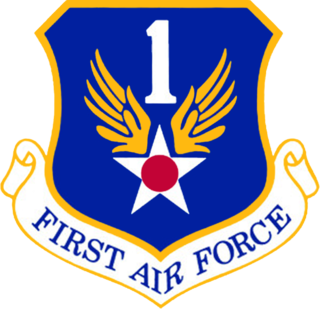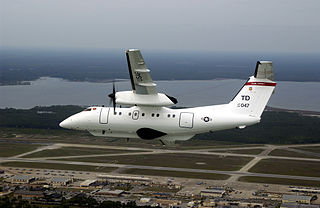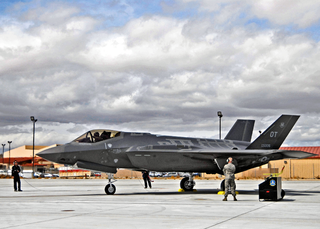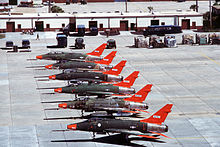
Tyndall Air Force Base is a United States Air Force Base located 12 miles (19 km) east of Panama City, Florida. The base was named in honor of World War I pilot 1st Lt. Frank Benjamin Tyndall. The base operating unit and host wing is the 325th Fighter Wing of the Air Combat Command (ACC). The base hosts 2,902 active duty members. In October 2018, Hurricane Michael caused significant damage to the base.

The First Air Force is a numbered air force of the United States Air Force Air Combat Command (ACC). It is headquartered at Tyndall Air Force Base, Florida. Its primary mission is the air defense of the Contiguous United States (CONUS), United States Virgin Islands and Puerto Rico. Since May 2022, it also provides the Air Force contribution to United States Space Command, as Air Forces Space (AFSPACE), including support functions for NASA human space flight.

The Southeast Air Defense Sector (SEADS), was a unit of the US Air Force located at Tyndall Air Force Base near Panama City, Florida. It provided air defense and surveillance of the southeastern region of the US. SEADS closed in winter 2005, giving up surveillance and control of their airspace to the Eastern Air Defense Sector (EADS) and the former Northeast Air Defense Sector (NEADS).

Aerospace Defense Command was a major command of the United States Air Force, responsible for continental air defense. It was activated in 1968 and disbanded in 1980. Its predecessor, Air Defense Command, was established in 1946, briefly inactivated in 1950, reactivated in 1951, and then redesignated Aerospace rather than Air in 1968. Its mission was to provide air defense of the Continental United States (CONUS). It directly controlled all active measures, and was tasked to coordinate all passive means of air defense.

The 82nd Aerial Targets Squadron is a United States Air Force unit. It is assigned to the 53rd Weapons Evaluation Group and stationed at Tyndall Air Force Base, Florida.

The 4704th Defense Wing is a discontinued United States Air Force organization. Its last assignment was with the 25th Air Division of Air Defense Command (ADC) at McChord Air Force Base, Washington, where it was discontinued in 1954. It was established in 1952 at McChord in a general reorganization of ADC, which replaced wings responsible for a base with wings responsible for a geographical area. It commanded three fighter interceptor squadrons initially, and added three more squadrons before the end of the year. In early 1953 it added several radar squadrons in the Pacific Northwest, one of which was an Air National Guard squadron mobilized for the Korean War. When it was discontinued in the fall of 1954 its units transferred to the 25th Air Division.

The 144th Fighter Wing is a unit of the California Air National Guard, stationed at Fresno Air National Guard Base, California. As part of the Air Reserve Component of the United States Air Force, the wing is operationally gained by the Air Combat Command.

The 53d Wing is a wing of the United States Air Force based at Eglin Air Force Base, Florida. The wing reports to the United States Air Force Warfare Center at Nellis Air Force Base, Nevada, which in turn reports to Headquarters Air Combat Command.

The 325th Fighter Wing is a wing of the United States Air Force based in Tyndall Air Force Base, Florida.

The 2nd Fighter Training Squadron, sometimes written as 2d Fighter Training Squadron, is an active United States Air Force unit, assigned to the 325th Operations Group at Tyndall Air Force Base, Florida.

The 95th Fighter Squadron, nicknamed the Boneheads, is an active squadron of the United States Air Force. Last activated on 15 June 2023 as a Lockheed Martin F-35 squadron stationed at Tyndall Air Force Base, Florida. Previously the 95 FS was an F-22 equipped squadron, but in 2019 the squadron's aircraft and personnel were distributed across other bases in the aftermath of Hurricane Michael in 2018 and its destruction of large parts of Tyndall Air Force Base. It was subsequently disbanded in 2019. The unit is scheduled in August 2023 to receive its first Lockheed Martin F-35A Lightning II aircraft.

The 162nd Attack Squadron is a unit of the Ohio Air National Guard 178th Wing located at Springfield Air National Guard Base, Springfield, Ohio. The 162nd is equipped with the General Atomics MQ-9 Reaper UAV.

The United States Air Force Warfare Center (USAFWC) at Nellis Air Force Base, Nevada, reports directly to Air Combat Command. The center was founded on September 1, 1966, as the U.S. Air Force Tactical Fighter Weapons Center. It was renamed the U.S. Air Force Warfare Center in 2005.

The 31st Combat Training Squadron is an active United States Air Force unit. It is currently assigned to the Nevada Test and Training Range at Nellis Air Force Base, Nevada.

The 460th Fighter-Interceptor Training Squadron is an inactive United States Air Force unit. Its last assignment was with Tactical Air Command's 325th Fighter Weapons Wing at Tyndall Air Force Base, Florida, where it was inactivated on 15 October 1982.

The 4756th Air Defense Wing was the designation of two different discontinued United States Air Force organizations. Both wings were stationed at Tyndall Air Force Base, Florida and fulfilled similar missions. The first was organized in 1957 when Air Defense Command (ADC) assumed responsibility for managing Tyndall from Air Training Command and focused on weapons testing and development and evaluating the readiness of ADC fighter units. The wing also controlled a ground control intercept radar squadron. This wing was discontinued in 1960 and its mission transferred to its parent 73d Air Division.

The 4756th Air Defense Group (Weapons) is a discontinued United States Air Force organization. Its last assignment was with the 4756th Air Defense Wing of Air Defense Command (ADC) at Tyndall Air Force Base, Florida, where it was discontinued in 1963.

The 325th Operations Group is the flying component of the 325th Fighter Wing, assigned to Air Combat Command of the United States Air Force. The group is stationed at Tyndall Air Force Base, Florida. It conducts training on the Lockheed Martin F-22 Raptor and commands one operational Raptor squadron. It directs the flying and support operations of two F-22 squadrons, a fighter training squadron, an operations support squadron and a training support squadron.

Air Defense, Tactical Air Command (ADTAC) was a Named Unit of the United States Air Force, and operated at the Numbered Air Force echelon of Tactical Air Command. It was responsible for the air defense of the United States, and was last stationed at Langley Air Force Base, Virginia. It was last assigned to Tactical Air Command, and was inactivated on 6 December 1985.

Moody Air Force Base (AFB) is a United States Air Force installation near Valdosta, Georgia.























